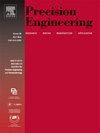Numerical simulation of the effect of scratching parameters and crystal orientation on the surface scratching mechanism of single-crystal γ-TiAl alloy
IF 3.5
2区 工程技术
Q2 ENGINEERING, MANUFACTURING
Precision Engineering-Journal of the International Societies for Precision Engineering and Nanotechnology
Pub Date : 2025-01-31
DOI:10.1016/j.precisioneng.2025.01.020
引用次数: 0
Abstract
The study investigated the effects of different tip radii and scratch depths of diamond conical indenter on the surface nano-scratching mechanism of single-crystal γ-TiAl alloys using Molecular Dynamics (MD) simulations. Effectively combining the scratching parameters with crystal orientation, the variation rules of temperature, mechanical response, atomic flow, subsurface damage, and surface morphology during the scratching process are revealed. The results demonstrate that increasing indenter tip radius and scratch depth lead to higher values of scratch force, temperature, and degree of subsurface damage. Moreover, the average coefficient of friction (COF) and removal rate of atomic wear increase with an increase in the ratio between scratch depth and indenter tip radius (d/r), also known as relative tool sharpness (RTS), a larger RTS facilitates generating more pile-up on both sides. In comparison, a smaller RTS concentrates chips at the indenter's tip. Furthermore, crystal orientation significantly influences the extent to which scratching parameters affect the matrix, specifically, the crystal orientation exhibits higher scratch sensitivity. Finally, the optical morphology of the scratch was obtained by scratch experiment and qualitatively compared with the simulation results. The research results provide valuable insights for the selection of machining parameters of γ-TiAl alloy at nano-scale.
刻划参数和晶向对单晶γ-TiAl合金表面刻划机理的影响
采用分子动力学(MD)模拟研究了金刚石锥形压头不同刀尖半径和划伤深度对单晶γ-TiAl合金表面纳米划伤机理的影响。将刻划参数与晶体取向有效结合,揭示了刻划过程中温度、力学响应、原子流动、亚表面损伤和表面形貌的变化规律。结果表明,随着压头尖端半径和划痕深度的增加,划痕力、温度和亚表面损伤程度都有所增加。此外,平均摩擦系数(COF)和原子磨损去除率随着划痕深度与压头尖端半径之比(d/r)的增加而增加,也称为相对刀具锐度(RTS),较大的RTS有利于产生更多的两侧堆积。相比之下,较小的RTS将芯片集中在压头尖端。此外,晶体取向显著影响划伤参数对基体的影响程度,特别是(001)[1 - 1 - 0]晶体取向表现出更高的划伤敏感性。最后,通过划痕实验获得划痕的光学形貌,并与仿真结果进行定性比较。研究结果为γ-TiAl合金纳米级加工参数的选择提供了有价值的见解。
本文章由计算机程序翻译,如有差异,请以英文原文为准。
求助全文
约1分钟内获得全文
求助全文
来源期刊
CiteScore
7.40
自引率
5.60%
发文量
177
审稿时长
46 days
期刊介绍:
Precision Engineering - Journal of the International Societies for Precision Engineering and Nanotechnology is devoted to the multidisciplinary study and practice of high accuracy engineering, metrology, and manufacturing. The journal takes an integrated approach to all subjects related to research, design, manufacture, performance validation, and application of high precision machines, instruments, and components, including fundamental and applied research and development in manufacturing processes, fabrication technology, and advanced measurement science. The scope includes precision-engineered systems and supporting metrology over the full range of length scales, from atom-based nanotechnology and advanced lithographic technology to large-scale systems, including optical and radio telescopes and macrometrology.

 求助内容:
求助内容: 应助结果提醒方式:
应助结果提醒方式:


